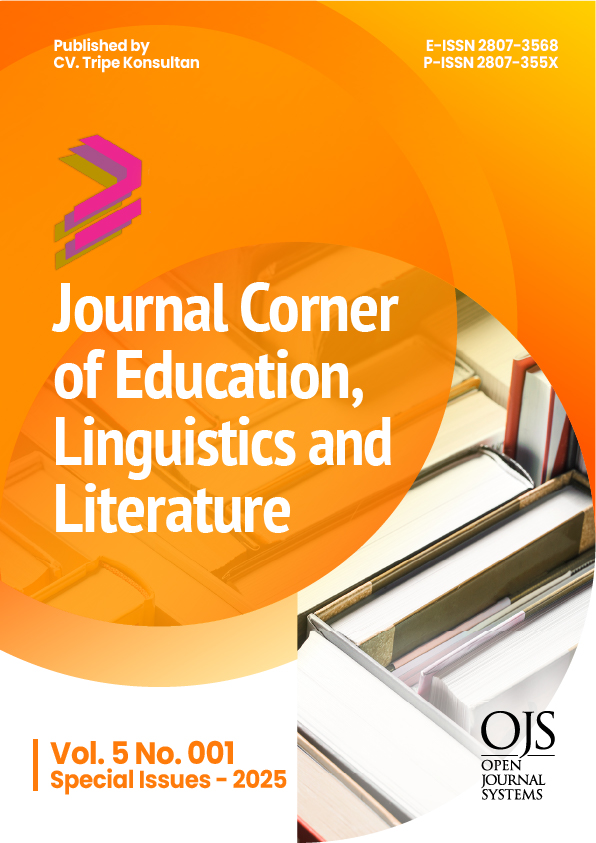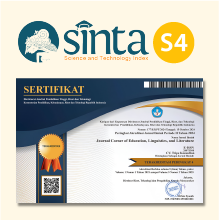Analyzing Workload and Turnover Intention through Work Stress: Strengthening Retention Strategies from an Educational Perspective
 https://doi.org/10.54012/jcell.v5i001.560
https://doi.org/10.54012/jcell.v5i001.560
 Abstract views: 177
Abstract views: 177
 PDF downloads: 121
PDF downloads: 121
Keywords:
Workload, Work Stress, Turnover Intention, Mediation;, Employee Retention, Human Resource Management, EducationAbstract
This study aimed to analyze the influence of workload on turnover intention with work stress as a mediating variable among employees of CV Semar Berkah Mandiri. A quantitative research approach was employed, involving 43 respondents selected through a saturated sampling technique. Data were collected using a structured questionnaire and analyzed using multiple linear regression, coefficient of determination (R²), t-tests, F-tests, and Sobel tests with the assistance of IBM SPSS 25. The results reveal that workload has a positive and significant impact on turnover intention. Moreover, workload also positively affects work stress, which, in turn, significantly increases turnover intention. Mediation analysis demonstrates that work stress plays a crucial mediating role in the relationship between workload and turnover intention. From an educational perspective, this study emphasizes the importance of employee development programs in mitigating the negative effects of workload and stress. Continuous training and organizational learning initiatives can strengthen employees’ resilience, adaptability, and problem-solving skills, thereby reducing turnover intention. Companies are encouraged to integrate educational initiatives into their human resource management strategies as part of a holistic approach to workload management and employee retention.
Downloads
References
Abdullah, M., Musriani, R., Syariati, A., & Hanafie, H. (2020). Carbon emission disclosure in Indonesian firms: The test of media-exposure moderating effects. International Journal of Energy Economics and Policy, 10(6), 732–741.*
Amaliyah, I., & Solikhah, B. (2021). Pengaruh karakteristik dewan komisaris dan komite audit terhadap pengungkapan emisi karbon. Jurnal Akuntansi Multiparadigma, 12(1), 24–40.
Barney, J. (1991). Firm resources and sustained competitive advantage. Journal of Management, 17(1), 99–120.
Bass, B. M., & Riggio, B. J. (2006). Transformational leadership (2nd ed.). Lawrence Erlbaum Associates.
Bryman, A. (2016). Social research methods (5th ed.). Oxford University Press.
Creswell, J. W., & Creswell, J. D. (2018). Research design: Qualitative, quantitative, and mixed methods approaches (5th ed.). Sage.
Dalkir, N. (2017). Knowledge management in theory and practice (3rd ed.). MIT Press.
Davis, G. C. (2022). The role of public value in digital transformation. Government Information Quarterly, 39(1), 101660.*
Eriksson, M., Gustafsson, T., & Persson, S. (2025). Strategic public management: Theory and practice. Nordic Academic Press.
Farhana, N. F., Hartati, W., & Risdianto. (2024). Pengaruh beban kerja terhadap turnover intention dengan stres kerja sebagai variabel mediasi. Jurnal Manajemen Sumber Daya Manusia, 9(2), 78–88.*
Flyvbjerg, B. (2006). Five misunderstandings about case-study research. Qualitative Inquiry, 12(2), 219–245.
Goetsch, D. L., & Davis, S. B. (2016). Quality management for organizational excellence: Introduction to total quality (8th ed.). Pearson.
Greenleaf, R. K. (2002). Servant leadership: A journey into the nature of legitimate power and greatness. Paulist Press.
Hamad, H. (2024). Digital communication strategies in the modern era. Journal of Strategic Communication, 12(1), 22–36.
Lee, S. M., & Trimi, S. (2018). Innovation for creating a smart future. Journal of Innovation & Knowledge, 3(1), 1–8.
Li, X., Chen, Y., & Wang, Z. (2020). Value-driven content and audience engagement in digital platforms. International Journal of Digital Marketing, 18(3), 144–159.*
McNabb, D. (2020). Research methods in public administration and nonprofit management (4th ed.). Routledge.
Miles, A. G., & Huberman, M. B. (2014). Qualitative data analysis (3rd ed.). Sage.
Mintzberg, H. (2005). Strategy safari: A guided tour through the wilds of strategic management (2nd ed.). Free Press.
Porter, M. E., & Heppelmann, J. E. (2014). How smart, connected products are transforming competition. Harvard Business Review, 92(11), 64–88.*
Sugiyono. (2023). Metode penelitian kuantitatif, kualitatif dan R&D (3rd ed.). Alfabeta.
Uhl-Bien, M., Marion, R., & McKelvey, B. (2007). Complexity leadership theory: Shifting leadership from the industrial age to the knowledge era. The Leadership Quarterly, 18(4), 298–318.*
West, D. (2022). Digital government: Technology and public sector performance. Brookings Review, 21(3), 30–33.*
Weber, M. S. (2023). Public policy communication in the digital age. Policy Sciences, 56(2), 211–230.
Yadav, M., & Rahman, Z. (2017). Social media engagement: Exploring the role of interactivity and accessibility. Journal of Consumer Behaviour, 16(5), 405–417.
Downloads
Published
How to Cite
Issue
Section
License
Copyright (c) 2025 Nur Fitria Farhana, Wiwi Hartati, Risdianto

This work is licensed under a Creative Commons Attribution-ShareAlike 4.0 International License.
All articles published in the Journal Corner of Education, Linguistics, and Literature are licensed under the Creative Commons Attribution-ShareAlike License (CC BY-SA).

















